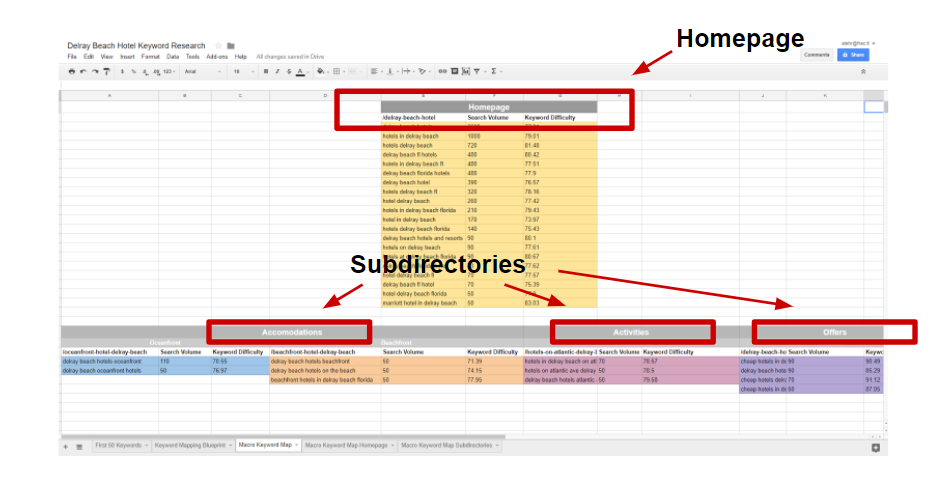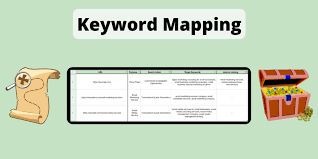To succeed in today’s digital world, you need a solid online presence that’s optimized for search engines. One of the best ways to increase your online visibility is through SEO. This will help bring in new customers and keep your current customers coming back for more and keyword mapping helps to increase online visibility.
Search Engine Optimization (SEO) is a broad term that describes a number of techniques for optimizing websites to get them to appear higher in search engine results.
One of the most important techniques for a successful search engine strategy is the term mapping. At its core, keyword mapping involves identifying and organizing relevant keywords to ensure that your website ranks higher in search engine results pages (SERPs) for those specific keywords.
In simpler terms, keyword mapping helps you understand the terms people are searching for and how to structure your website’s content to target those terms. You can use this to increase your website’s visibility, generate more traffic, and ultimately lead to more leads and sales.
In this guide, we will provide an overview of keyword mapping, including the basics, advanced techniques, and best practices. We’ll also cover how keyword mapping affects on-page and off-page SEO and how it can improve your content creation and analytics.
So, whether you’re new to SEO or a seasoned professional, this guide will equip you with the knowledge and skills to implement a successful keyword mapping strategy and boost your SEO efforts.
Understanding Keywords for Keyword Mapping
Keywords are the words that people type in when they type in Google, Yahoo, or Bing. That’s why it’s important to use keywords that are related to your business.
They’re searching for something specific. This makes sense since they want to give the most relevant result to someone looking for a specific answer. Keyword mapping is an integral part of any SEO strategy, and it’s important to know the differences between broad and more specific keywords.
Types of Keywords
There are several types of keywords that you should be aware of:
- Short-tail keywords: These keywords consist of one or two words and they have high search volume and are tough to compete. They are generic ones and also called seed keywords.
- Long-tail keywords: They are more specific keyword phrases, such as “best women’s running shoes for flat feet.” Long-tail keywords have a lower search volume but are easier to rank for and are more likely to attract your target audience.
- Branded keywords: These keywords include brand name, such as “Goldenpearl Cream” or “Dior Bags.” Branded keywords are both short-tail or long-tail.
Keyword Research
Keyword research is the process of identifying your target audience’s keywords to find information related to your business. It involves using keyword research tools to identify relevant keywords and analyzing search volume, competition, and user intent.
To help find relevant keywords, many tools including Google Keyword Planner, SEMrush, and Ahrefs can help.
Read more: How to conduct keyword research? Ultimate guide with tips & tricks
Keyword Analysis Tools to Use
After identifying your target keywords, you will analyze them to determine their competitiveness and value. Tools such as Google Trends, Moz, and Keyword Tool can help you analyze search volume, competition, and user intent.
Keyword Mapping Techniques
Keyword mapping is assigning relevant keywords to specific pages on your website to optimize them for search engines. This process involves identifying relevant keywords for each page, grouping them based on their intent and relevance, and then assigning them to specific on-page elements such as the page title, headings, meta descriptions, and content.
On-Page SEO, on the other hand, refers to the optimization of on-page elements of a website to improve its ranking in search engine results pages. It includes optimizing the page title, meta description, headings, content, images, and other on-page elements to ensure that they are relevant to the search query and provide a good user experience.
Keyword mapping plays a crucial role in on-page SEO as it helps to ensure that the relevant keywords are incorporated into the on-page elements in a natural and meaningful way. By mapping keywords to specific on-page elements, you can optimize your website for search engines and improve its visibility in search results.
Tips to Optimize On-Page SEO with Keyword Mapping
Here are some tips for optimizing on-page SEO with keyword mapping:
- Conduct keyword research to identify your website and pages’ most relevant and valuable keywords.
- Group keywords based on their intent and relevance to specific pages or topics on your website.
- Assign keywords to specific on-page elements, including the page title, headings, meta description, and content.
- Use the assigned keywords naturally and meaningfully throughout the on-page elements.
- Optimize images using descriptive file names, alt tags, and captions that include relevant keywords.
- Use internal linking to create a hierarchy of pages on your website and to signal to search engines which pages are the most important.
- Regularly monitor and analyze your on-page SEO performance and adjust your keyword mapping and on-page elements as needed.
By incorporating keyword mapping into your on-page SEO strategy, you can optimize your website for search engines and improve its ranking in search results, ultimately driving more traffic and leads to your website.
Keyword Mapping organizes relevant keywords to ensure that your website ranks higher in search engine results pages (SERPs). Effective keyword mapping can improve your website’s visibility and increase organic traffic.
There are two types of Keyword Mapping Techniques:
- Basic Keyword Mapping
- Advanced Keyword Mapping.
Basic Keyword Mapping Techniques
- Identify Your Primary Keywords: Your primary keywords are the most important keywords for your business. They should be the focus of your SEO efforts and used throughout your website.
- Group Keywords into Themes: Group your keywords into themes based on their relevance to your business. It will help you to organize your keywords and ensure that your website content is structured in a way that is easy for search engines to understand.
- Assign Keywords to Pages: Once you have grouped your keywords into themes, assign them to specific pages on your website. It will help you to create targeted content that is optimized for each keyword theme.
Advanced Keyword Mapping Techniques
- Analyze Your Competitors’ Keywords: Analyzing your competitors’ keywords can help you to identify opportunities for new keywords and themes that you may have missed. Use tools like SEMrush or Ahrefs to conduct a competitor analysis.
- Use Long-Tail Keywords: Long-tail keywords are longer and more specific keyword phrases that typically have less competition. Incorporating long-tail keywords into your keyword mapping strategy can help you to target specific audiences and improve your chances of ranking higher in search results.
- Conduct Keyword Gap Analysis: Conducting a keyword gap analysis can help you identify keywords that your competitors are using but are not using. Use tools like SEMrush or Ahrefs to identify these gaps and incorporate them into your keyword mapping strategy.
- Prioritize Keywords Based on Intent: Prioritize your keywords based on the user’s intent. Are they looking for information, or are they ready to make a purchase? Incorporating keywords that align with user intent can improve the relevance of your website content and increase the chances of converting visitors into customers.
- Use Semantic Keyword Mapping: Semantic keyword mapping involves using related keywords and phrases that are semantically linked to your primary keywords. It can improve the context and relevance of your content and increase your chances of ranking higher in search results.
By implementing these advanced keyword mapping techniques, you can take your SEO strategy to the next level and improve the visibility of your website.
Keyword Mapping and On-Page SEO
Keyword Mapping is identifying and organizing relevant keywords for your website’s pages to help improve its search engine ranking. It involves researching keywords your target audience uses to search for information related to your industry or niche. Then, the identified keywords are mapped to specific pages on your website based on their relevance.

On-Page SEO, on the other hand, is optimizing the website content and structure to improve its visibility and ranking in search engines. It includes optimizing the website’s title tags, meta descriptions, headings, and internal links, among other things.
The process of keyword mapping and on-page SEO are closely related. Effective keyword mapping allows you to identify the most relevant keywords to your content, which can be used to optimize your on-page SEO elements. Here are some ways in which keyword mapping and on-page SEO intersect:
What Optimization is Required?
- Optimizing Page Titles: By mapping keywords to specific pages, you can optimize the page titles with relevant keywords. It helps search engines understand what the page is about and improve its visibility in search results.
- Creating Meta Descriptions: Meta descriptions summarize what a page is about. By mapping keywords to specific pages, you can create more compelling and relevant meta descriptions that attract more clicks.
- Using Header Tags: Header tags (H1, H2, H3, etc.) help structure your content and make it more readable for users. By mapping relevant keywords to specific pages, you can use them in header tags to improve the content’s relevance and structure.
- Internal Linking: Internal linking is linking to other pages on your website. By mapping keywords to specific pages, you can link to other relevant pages on your website, improving their visibility and ranking.
Effective keyword mapping is crucial to optimizing your on-page SEO elements. It allows you to identify and use the most relevant keywords in your page titles, meta descriptions, header tags, and internal links, improving your website’s visibility and ranking in search engines.
Keyword Mapping and Off-Page SEO
Off-page SEO refers to the actions taken outside of your website to improve its ranking in search engine results pages (SERPs). It includes link building, social media marketing, and influencer outreach.
Keyword mapping plays an important role in off-page SEO because it helps you identify the most relevant keywords. They prove helpful for your business and target audience. It enables you to create content and outreach strategies that align with these keywords and boost your rankings in SERPs.
One of the primary ways that keyword mapping can improve your off-page SEO is through link building. When you identify the most relevant keywords to your business. You can use them as anchor text when creating backlinks to your website. It tells search engines that your website is a reputable source of information on that topic, which can improve your rankings in SERPs.
Helpful in Content
Keyword mapping can also help you to create content that resonates with your target audience. It encourages them to share it on social media. By identifying the keywords your target audience is searching for, you can create content that addresses their needs and interests. It can lead to more shares and backlinks to your website, which can boost your rankings in SERPs.
In addition to link building and content creation, keyword mapping can also help you to identify influencers in your industry who can help you to promote your brand. By identifying the most relevant keywords to your business, you can find influencers who are already talking about those topics and reach out to them for collaboration opportunities.
Keyword mapping is an important component of any successful off-page SEO strategy. By identifying the most relevant keywords to your business and target audience, you can create content and outreach strategies that align with these keywords and improve your rankings in SERPs.
Keyword Mapping and Content Creation
Keyword Mapping is the process of identifying and organizing keywords that are relevant to your website or content. This process helps you to create a targeted SEO strategy that focuses on specific keywords, which in turn can help improve your website’s search engine rankings.

When it comes to content creation, Keyword Mapping plays a vital role. By identifying the most relevant keywords to your content, you can create optimized content for search engines. Your content will be more likely to appear in search results when people search for those keywords.
Here are some tips for creating content using Keyword Mapping:
- Identify Your Target Keywords: Use keyword research tools to identify the most relevant keywords to your content. Look for keywords that have high search volume and low competition.
- Use Keywords in Your Content: Incorporate them into your content once you’ve identified your target keywords. However, be sure to use keywords naturally and use them wisely, as search engines can see this as spammy.
- Use Related Keywords: In addition to your target keywords, use related keywords that are semantically similar to your target keywords. It can help your content appear in search results for related queries.
- Use Headings and Subheadings: Use headings and subheadings to structure your content and incorporate your target keywords. It helps with SEO and makes your content easier to read.
- Focus on Quality: While Keyword Mapping is important, it’s also essential to focus on creating high-quality content. Your content should be engaging, informative, and relevant to your audience.
Overall, Keyword Mapping and Content Creation go hand in hand with SEO. By using Keyword Mapping to identify your target keywords and incorporating them into your content, you can create content that is optimized for search engines and provides value to your audience.
Keyword Mapping and Analytics
Analytics play a crucial role in the success of any SEO strategy, and keyword mapping is no exception. Keyword mapping helps identify the most relevant and high-performing keywords for your website. It provides insights into how those keywords perform in search engine results pages (SERPs). By analyzing the data generated by keyword mapping, you can gain valuable insights into your website’s performance. Moreover it will help to identify areas for improvement, and optimize your SEO strategy for better results.
Overview of Analytics
Analytics refers to collecting, measuring, analyzing, and interpreting data about user behavior and website performance. It involves tracking various metrics and key performance indicators (KPIs) to gain insights into how users interact with your website, where they come from, and how they behave. Analytics tools like Google Analytics can provide detailed data on your website’s traffic, bounce rates, time on page, and more.
How Keyword Mapping Can Benefit Analytics
Keyword mapping can improve the accuracy and relevance of the data collected through analytics. By mapping keywords to specific pages or sections of your website, you can track those pages’ performance more effectively. It makes you better understand how users find and interact with your content. It can help you identify areas for improvement, such as pages with a high bounce or low conversion rates, and make data-driven decisions to optimize your website’s performance.
Analyzing Keyword Data
To get the most out of your keyword mapping efforts, it’s important to analyze the data generated by your analytics tools. By reviewing key metrics like click-through rates, conversion rates, and bounce rates for specific keywords and pages, you can gain valuable insights into your website’s performance and where you can improve. For example, if you notice that certain keywords have high click-through rates but low conversion rates, you may need to adjust the content on those pages to meet user needs and improve conversion rates.
Tools for Analyzing Keyword Data
Many tools are available for analyzing keyword data and gaining insights into your website’s performance. Google Analytics is a popular tool that provides detailed data on your website’s traffic, user behavior, and conversion rates. Other tools like SEMRush and Ahrefs can provide insights into keyword performance, competitor analysis, and more. Using these tools in conjunction with your keyword mapping efforts, you can better understand your website’s performance and optimize your SEO strategy for better results.
In conclusion, keyword mapping and analytics are important components of any successful SEO strategy. By mapping keywords to specific pages or sections of your website and analyzing the data generated by analytics tools. You can gain valuable insights into your website’s performance and optimize your SEO strategy for better results.
Conclusion:
In conclusion, keyword mapping is crucial to any successful SEO strategy. You can improve your website’s search engine rankings by identifying and organizing relevant keywords and attracting more organic traffic. With the techniques and tips in this guide, you can create a successful keyword mapping strategy. I hoe these strategies will drive results for your website. Remember, keyword mapping is an ongoing process, so monitor and update your keywords regularly to stay ahead of the competition.
